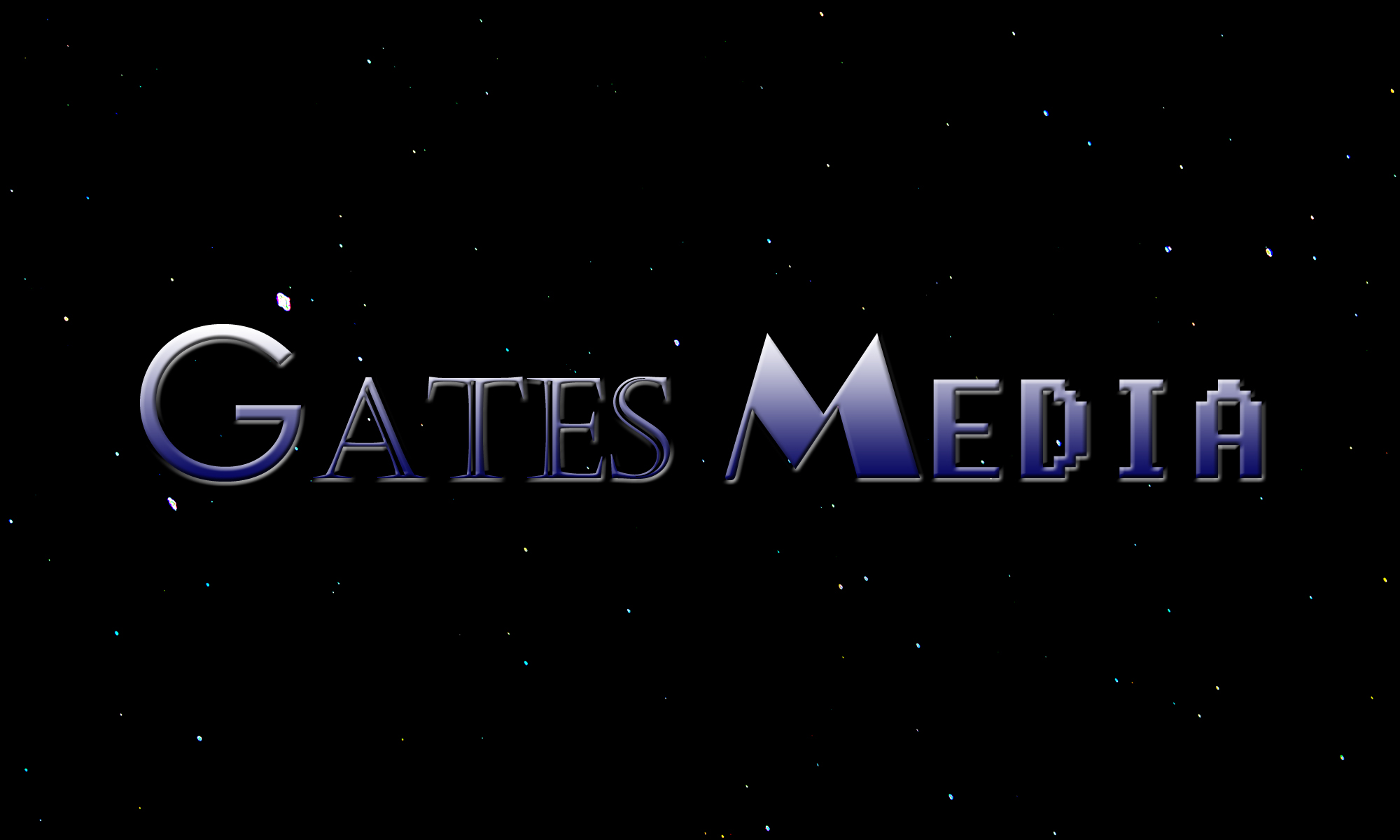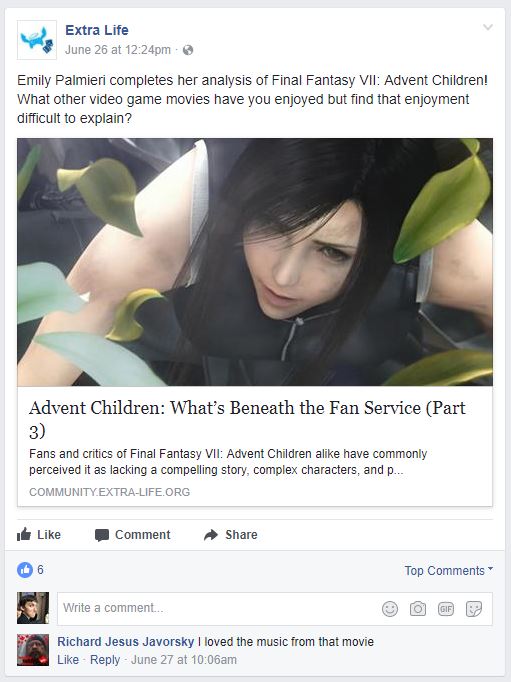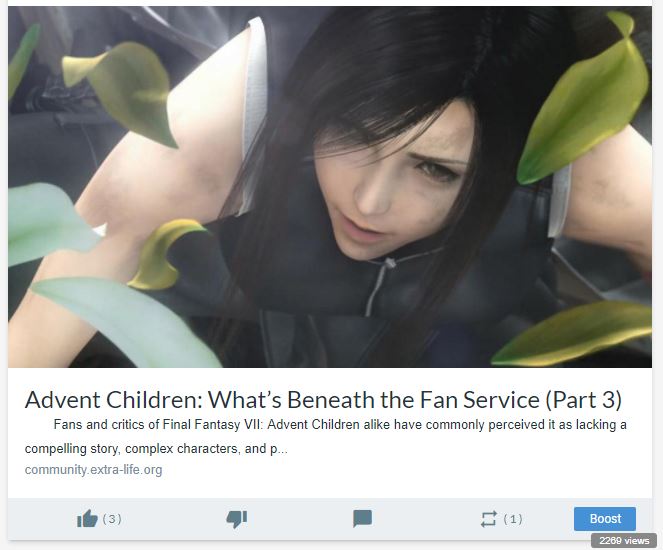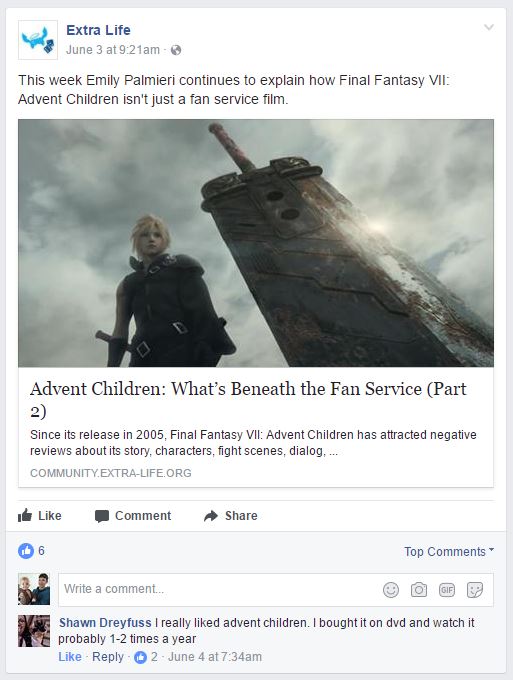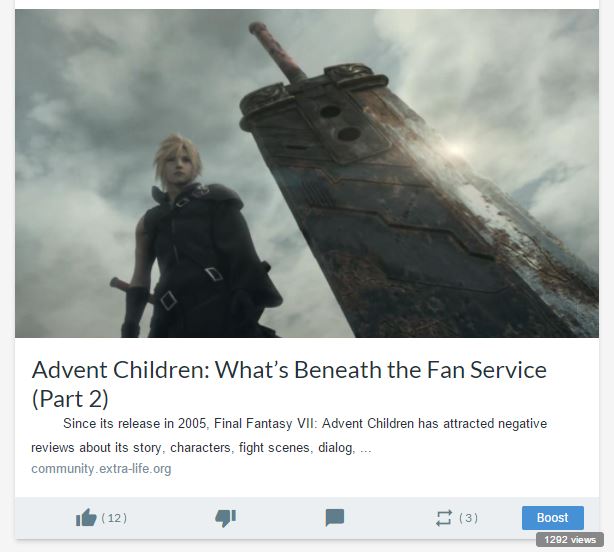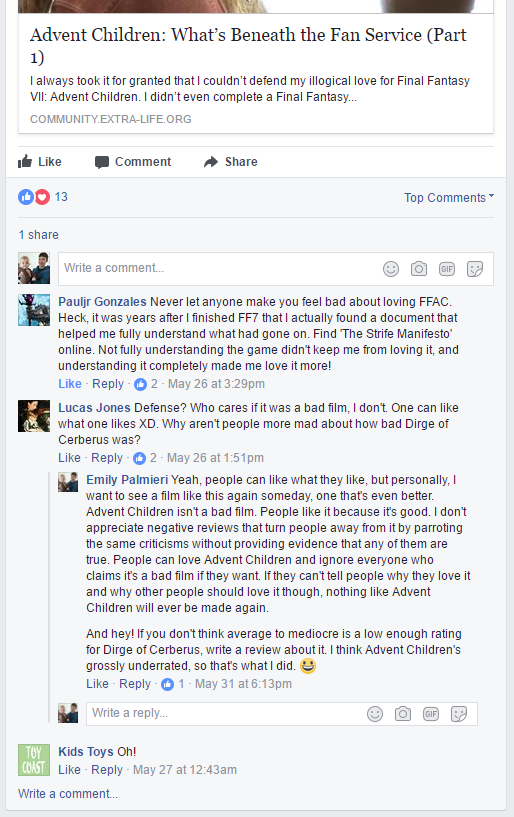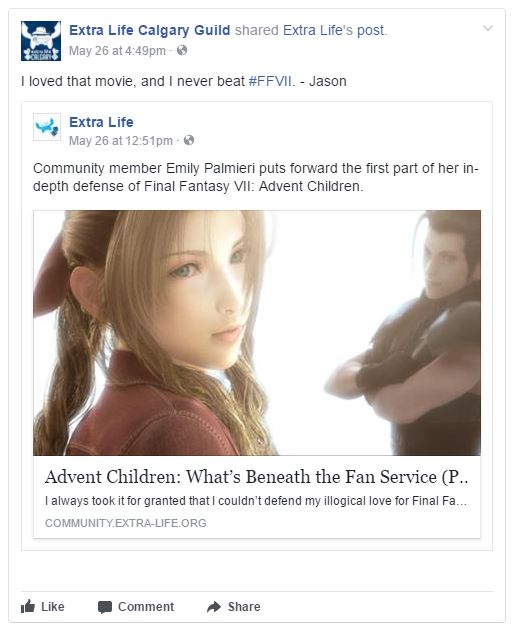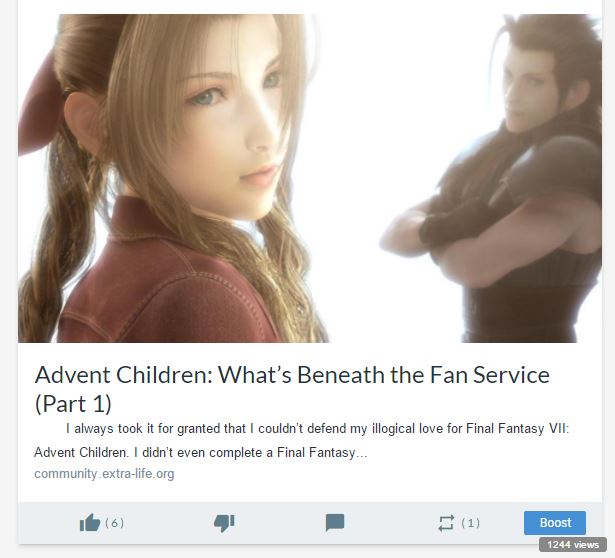Advent Children: What’s Beneath the Fan Service (Part 3)
Hello once again, Final Fantasy VII: Advent Children fans! Have you ever read a review of Advent Children and wondered if the author actually watched the movie? How about listening to reviewers parrot common criticisms about the film only to finish by saying that they love it? How can this film be so amazing and so unique and still receive dominantly negative reviews claiming that it is everything it is not?
Advent Children: What’s Beneath the Fan Service is a three-part series in which I debunk common misconceptions about what is arguably one of the most important CGI movies ever made. Part 1 analyzed Advent Children’s story, characters, and themes. Part 2 discussed how the film tells its story through action. Now, part 3 speculates why Advent Children is so misunderstood and argues its importance in filmmaking history. You can find it here.
Thank you so much for reading. I hope this glimpse beneath the fan service gives you the courage to tell people why you love this movie and why they should love it, too. What does Advent Children mean to you?
I’d like to thank Jack Gardner and Extra Life for supporting this series. For those of you who don’t know, Extra Life is like a marathon for charity, but instead of running or walking, you play video games to raise money for a Children’s Miracle Network Hospital of your choice. The official Extra Life event happens November 4 this year, but you can raise money whenever you want year round. Check out the Extra Life website to learn more, donate, and sign up!
Kingsglaive vs Advent Children: Where Nonsense Originates
Transcript:
Kingsglaive: Final Fantasy XV and Final Fantasy VII: Advent Children get compared a lot. They both contain extravagant action scenes, were created by Square Enix, and are based on games in the Final Fantasy franchise. Both also receive criticism for having convoluted and confusing plots. But how justified is this comparison? In a previous video, I talked about how Kingsglaive’s visuals contradict its audio and its general visual chaos. Is that all that makes its story incoherent? Does Advent Children have the same problem with visual communication? Let’s compare three aspects of their stories to find out.
Both films feature protagonists with inner conflicts that they must confront. Nyx in Kingsglaive deals with the deaths of his mother and sister and his status as an immigrant… supposedly. The film shows the source of Nyx’s torment through a poster board in his room, which has photos of his family and characters likely drawn by his sister. Nyx also watches a cartoon on TV that features the same characters. Nyx, however, looks at these things with indifference… or maybe rage. Is he tormented, or is he just eating something? Stop changing the camera angle every two seconds!
He seems to have a fear that his past will lead to his death. Maybe? What prompted him to think this thought? He’s just sitting on the steps, and then, some guy falls out of the sky and vomits. Nyx hears his sister’s voice throughout the film, but these memories only cause mild inconveniences.
Similarly, guards only occasionally taunt his immigration status. The rest of the time he just plows through them. [“Hey, hey, hey, hey, hey, hey! Wait a minute! Stop!”] Despite the suggestion that he must overcome these problems, we don’t ever know why they’re problematic… except when he decides Princess Luna needs to know about his sister mid-chase scene.
In contrast, Cloud’s inner torment in Advent Children is clearly a problem that he must solve if he expects to survive the film. Cloud deals with the deaths of his friends Zack and Aerith and his affliction with an incurable disease called geostigma. He experiences intrusive visions from his past at inopportune times. He pushes his surviving friends away out of guilt. He feels pain and bleeds blue ink from geostigma. Cloud’s battle against his inner demons makes it difficult for him to fight the enemies resurrected from his past in reality. His inner problems integrate so well with his external struggles that battling his enemies and reuniting with his friends is synonymous with letting go of his past and finding his place in the present.
Kingsglaive and Advent Children also have bad guys that must obtain something important to fulfill their evil plans. In Kingsglaive, the empire Niflheim wants to steal the kingdom of Lucis’ Crystal, which it uses to defend its capital city Insomnia with a magical wall; obtain a magical ring from Lucis’ King Regis; kill and/or kidnap Lucis’ ally Princess Luna; and/or kill King Regis. If that previous semblance of a sentence didn’t clue you in, Kingsglaive doesn’t explain why Niflheim or Lucis care about any of these goals. Let’s look specifically at the Crystal, which at first glance appears to be the most powerful object in the movie. The Crystal is so important in fact that it’s the first thing that we see in the film.
Unfortunately, the scenes during which Niflheim steals it are so chaotic that they render its importance questionable at best. During a distraction peace treaty, Niflheim’s troops enter a smoky room outside the Crystal’s hold. [“The Crystal! They’re after the Crystal!”] The troops break into a room with a control board and a vault door leading to the Crystal. They blow up the control panel, which causes Insomnia’s wall to fall. [“The wall, it’s gone.”] Later, Niflheim’s chancellor and emperor watch one of their ships carry the Crystal away.
It sounds straightforward… until you mix it with King Regis’ battle against robots and a menacing suit of armor and Nyx’s fight with traitorous teammates and a giant octopus. Additionally, the Crystal doesn’t look like a crystal, and this movie doesn’t like to hold any of its shaky and poorly chosen shots for more than two seconds. There’s a reason why the characters narrate this entire heist. “They broke into a room with a… panel? Where’s the Crystal?” “What is this black thing covered in smoke?” [“The Crystal!”] “Oh, you mean this window divider is the Crystal?”
The aftermath doesn’t stress the importance of this event either. No one cares. Nyx and Luna point out that the wall has fallen before they return to killing traitors. The ambassador and the emperor of Niflheim talk about what happens next. “The Crystal…! Well, let’s go see if King Regis is still alive.” With the editing and cinematography, stealing the Crystal has as much weight as saving Luna from octopods and King Regis fighting for his life. In the end, do any of them matter? The Crystal’s gone. Regis dies. Luna throws herself out of an airship and yet is entrusted with a magic ring that no one can wear.
Advent Children’s antagonist Kadaj wishes to find the remnants of Jenova, an alien being that caused a catastrophe long ago. When Kadaj discovers the alien matter hidden in plain view, the film highlights its importance by making an event out of it. The possessor, Rufus, and Kadaj attract the attention of almost every major member of the cast when Rufus tosses Jenova’s remains off a building, and he and Kadaj jump after them in slow motion. Kadaj tries to grab the box out of the air while Rufus shoots at it.
This scene occurs between two fight scenes, but they all feel very different, which makes it stand out. This scene features a desperate few seconds dragged out into almost a minute. The previous scene shows Cloud rediscovering friendship power, and the next has a high-speed motorcycle battle. While we don’t know until the end of the movie what Kadaj will do with Jenova, the dramatic visuals in this scene foreshadow the importance of him obtaining it.
Finally, the protagonists in both films must follow the clues to reach their goals and solve problems. Nyx tends to just know things for no reason. [“Your hairpin. They’re tracking it. Give it to me.”] [“Pelna, get out of there! It’s a trap!”] At one point, Nyx discovers a pattern on an enemy monster and somehow makes the connection that it’s attracted to a hairpin that Luna wears despite neither of them bearing any resemblance to one another. Similarly, he somehow determines that a trap octopus monster is onboard an airship in response to his teammate observing enemy guards. These are relatively minor problems in comparison to Nyx’s unexplained faith that a suicidal woman, a ring that kills everyone who wears it, and an absent prince have more importance to the future that he wants to save than an entire city of people who might have lived in it.
In contrast, the characters in Advent Children know surprisingly little about anything. [“So what’s going to happen now?”] [“Where’s Mother?”] [“Kadaj, what is he?”] [“Who’s that?”] [“What’s this stuff about Mother?”] [“What do you mean?”] Cloud seems clueless as to how Kadaj will reincarnate Sephiroth right up until Kadaj shoves Jenova cells in his chest. He doesn’t know the cure for geostigma until he’s cured. He doesn’t even seem know what happens at the end of the movie. [“It’s like she said: ‘Wait here and Cloud will come back.'” …] The film provides visual clues for the audience to interpret what happened, but the characters don’t usually do this themselves, at least not audibly.
This final point sums up what Advent Children and Kingsglaive do that makes their stories confusing to follow. They depict two visual storytelling extremes. Advent Children shows all its clues but rarely interprets what they mean audibly while Kingsglaive states what difficult to decipher and non-existent visual clues mean even when that interpretation doesn’t make sense. I’ll let you decide if a blank stare is a preferable explanation to: [“Your hairpin. They’re tracking it. Give it to me.”]
So how do their fight scenes compare? That’s a subject for another video. Talk at you next time.
[“A man’s past is his pride.” “No, my pride is shaping the future.”]
Advent Children: What’s Beneath the Fan Service (Part 2) Response
Advent Children: What’s Beneath the Fan Service (Part 1) Response
Advent Children: What’s Beneath the Fan Service (Part 1)
You can find The Strife Manifesto here. It’s an interesting analysis of Cloud’s character in the game.
Advent Children: What’s Beneath the Fan Service (Part 2)
Hello again, Final Fantasy VII: Advent Children fans! Have you ever wondered what makes Advent Children’s high-speed motorcycle battles, giant swords, and physics-defying action awesome? What does this movie do that other action movies don’t? Would you believe that Loz throwing a motorcycle with his feet, friendship defeating Bahamut, and a gunshot wound threatening to kill Cloud all follow a consistent set of rules?
Advent Children: What’s Beneath the Fan Service is a three-part series in which I debunk common misconceptions about what is arguably one of the most important CGI movies ever made. Part 2, now up on the Extra Life Community website, discusses how Advent Children tells its story and defines its world through action, visual language, and efficient dialog. You can find it here. If you missed part 1, which analyzes the story Advent Children tells, you can read that here.
Feel free to spread this around! If you want more movies like Advent Children, don’t be afraid to tell people why you love it and why they should love it, too. Everyone needs to know what’s beneath the fan service.
For those of you who don’t know, Extra Life is like a marathon for charity, but instead of running or walking, you play video games to raise money for a Children’s Miracle Network Hospital of your choice. The official Extra Life event happens November 4 this year, but you can raise money whenever you want year round. Check out the Extra Life website to learn more, donate, and sign up!
Advent Children: What’s Beneath the Fan Service (Part 1)
Hey, Final Fantasy VII: Advent Children fans! Have you ever wondered if Advent Children is more than fan service? Do you question why you like a film known for its poor story, weak characters, and unrealistic action scenes? Would it surprise you to know that criticisms of Advent Children have little to no basis in reality?
Advent Children: What’s Beneath the Fan Service is a three-part series in which I debunk common misconceptions about what is arguably one of the most important CGI movies ever made. Part 1, now up on the Extra Life Community website, analyzes Advent Children’s story, characters, and themes under a lens that has little to do with the game it’s based on. You can find it here.
Feel free to spread this around! Fans and haters alike need to know what’s beneath the fan service.
For those of you who don’t know, Extra Life is like a marathon for charity, but instead of running or walking, you play video games to raise money for a children’s hospital of your choice. The official Extra Life event is on November 4 this year, but you can raise money whenever you want year round. Check out the Extra Life website to learn more, donate, and sign up!
Final Fantasy VII: Advent Children – What We Had To Watch Response
(To those of you who stumble across this, I realized belatedly that my response to this video wasn’t a YouTube comment. Now I’m too lazy to change it. 😛 Normally, I don’t do comments or responses, but I really appreciated this video’s insight.)
Hi, Il Neige! Thanks for the thoughtful review of Advent Children! People don’t examine this movie’s merits and flaws enough. I’m a CGI movie enthusiast, and I really appreciated your insight. There are a few things I want to point out though. I apologize for the novel, but I like talking about this stuff.
It seems some of your complaints come from the idea that Advent Children is supposed to be something that it’s not. You say that Advent Children doesn’t expand the lore of Final Fantasy VII. Does it have to? I feel like Advent Children serves multiple purposes. It has fan service, but it also just tells a weird story about a guy struggling to accept his past and find his place in the present. While it services fans of the games and maybe sells Dirge of Cerberus, it tells a complete, character-driven story that I think anyone can watch, analyze, and pull meaning from. You spend a lot of time in this video simply talking about Advent Children’s themes and characters but go on to say that you wish it were something else when I think what you described is a really interesting story that’s worth telling. Who cares that it doesn’t expand on the universe that it takes place in? Final Fantasy VII is simply the medium that this story is told through.
You say the problem that plagues all video game movies is that they’re not interactive. Does this make all action movies boring because you can’t tell the characters to attack one another? The fact that they’re not interactive is a weakness of the movie medium, not of Advent Children or of video game movies in particular.
You also say that Advent Children looks realistic but simultaneously defies physics akin to live-action anime. Does anyone in this movie actually look like a real person though? I would argue, no. Nobody looks real. They’re a bit too perfect and alien to be real, and I don’t think the goal was photorealism. The look and style of the film doesn’t stray that far from the look and feel of Final Fantasy cut scenes. It just looks a little nicer.
I would also say that Advent Children isn’t anime though. Do you think of video game cut scenes as cartoons? Where is the line between acceptably realistic and cartoon CGI, and why are there categories? CGI is a different art form that, while it can take inspiration from other mediums such as video games, live-action movies, and cartoons, has its own strengths and weaknesses. For example, making something explode in CG is extremely easy while making characters hold hands is extremely difficult. Making something explode with 2D animation is very difficult, but making characters hold hands is trivial. We can forgive the poofy explosions in 2D animation and guns that jump from a table to a character’s hands in video games because they get the idea across. Putting blood and dirt on a character may not be as simple with CGI as it is to put makeup on an actor or paint on a cell, but Advent Children still shows the impact of violence in other ways.
A lot of your complaints come from the idea that most of Advent Children’s fight scenes are just visual spectacles, but I don’t think this is the case. They build the physical limitations of the world and its characters. The first fight scene introduces motorcycle chase scenes and gravity defying action, which we see for the rest of the film. Cloud getting his goggles shot off shows that the characters can withstand a lot of damage, and they do for the rest of the movie, but it also implies that they can be hurt. The fight between Loz and Tifa shows that the characters can also jump really high and have super human strength. This fight scene and the next one between Cloud and Kadaj’s gang shows that the bad guys pose a threat, even to the people who saved the world two years ago and have super human abilities. The fight with Bahamut shows that together, Cloud and his friends can defeat the bad guys. The motorcycle chase scene between Cloud, Kadaj, Loz, and Yazoo uses every single element that we’ve learned about from all previous fight scenes: high jumping, motorcycle chases, sword fighting, super strength, etc. The final battle with Sephiroth places itself on an even higher level by giving Sephiroth the ability to outright fly. He doesn’t need to high jump.
The fight scenes also one up each other by heightening the stakes. In the first fight scene, Cloud is only fighting to save himself. In the next scene, Tifa is fighting to save herself and Marlene. In the scene after that, Cloud fights to save a bunch of children. In the scene after that, Cloud and his friends fight to protect the citizens of the city. After that, Cloud fights Kadaj, Loz, and Yazoo to prevent the resurrection of Sephiroth, which could lead to the destruction of the world. Finally, Cloud fights Sephiroth, a god-like being, to save the world.
You mention that the camera work defies basic filmmaking techniques. I’d argue that the movie actually follows the 180 degree rule really well, and for the most part, the shots are wide to show the action and where the characters are located in relation to one another and in the scene. Its camera shots are interesting and would be very difficult to recreate in a live-action movie or anime, but that doesn’t mean they’re bad. This isn’t a terrible action movie that uses shaking camera angles, two-second-long shots, and closeups to hide its crappy choreography. Advent Children’s use of disorienting camera angles, mostly during Cloud’s fight with Sephiroth, seem to be used to show Cloud’s emotional state: frantic, confused, and scared.
There’s also reason to emotionally invest in every fight scene, even before Vincent reveals the details about Sephiroth and geostigma. While we don’t understand why Cloud is attacked in the first fight scene, neither does Cloud. He’s just trying to survive and figure out what the hell is going on. He’s immediately a character we can sympathize with and root for because we don’t know what’s going on either. We can care about Tifa and Loz’s fight because Tifa is a friend of Cloud’s, she doesn’t know what’s going on, and she needs to protect an innocent child from this creepy guy in black leather. In Cloud’s fight with Kadaj, Loz, and Yazoo, he’s weakened and caught off balance from the moment he enters the fight. He came to save the kids from creepy guys in black leather, but his own memories and fears get in his way. We don’t need to know about geostigma’s origins or Shinra or Kadaj’s motivations in order to sympathize with these needs to survive and save children from creepy dudes. The movie simply hasn’t explained the more abstract concepts yet.
You argue that there aren’t any stakes because there aren’t implications that the characters can be hurt. For example, how can we believe that Cloud will die of a gunshot after surviving rocks falling on top of him? Keep in mind that Cloud saved the world two years ago only to be struck down by an incurable disease. Despite all the strength these characters have, they’re still human. Cloud doesn’t actually receive an injury from rocks falling on top of him, but it does drain his energy and fill him with fear. This moment, where he must fight a god-like being while trying not to be crushed by large falling rocks, actually begins Cloud’s downfall in the fight. When he escapes the falling rock pile, he collapses and doesn’t regain strength until the memories of his friends re-empower him. Shots of his face during and before the rocks fall shows his desperation and fear.
Most of the implications that characters can be severely hurt or die comes from their emotional and physical reactions. For me personally, I find this much more powerful than movies that kill the majority of the supporting cast and thousands of civilians to try to convince me that its emotionally sterile and apparently invincible protagonist is somehow in physical danger. Cloud’s never stabbed, shot (without protection from sturdy glasses), or exploded until the end of the movie, but he does tire quite easily and is controlled by his emotions and illness. This means that for most of the movie, we’re left in suspense as to what his physical limits are until it reveals that he’s vulnerable to stabbing, bullets, and explosions. The only reason he survives these things is because his friends, particularly Aerith, help him.
Sure, maybe more people could die of geostigma to show that it’s more of a threat. And maybe having Loz, Yazoo, Reno, and Rude survive an explosion for the sake of visual flair was a bad idea. But how would killing Cloud or anyone else in the movie serve its themes? Cloud is already lamenting the deaths of two people. Why should he need to lament anyone else’s? At the end of the movie, Cloud chooses his friends and life over his memories of Aerith and Zack and acceptance of death. Sephiroth’s survival symbolizes that the Lifestream’s cycle of life and death, peace and peril will continue as it always has.
Finally, you say that the final fight scenes contradict the movie’s themes and ideas. Cloud’s friends disappear after the fight with Bahamut despite their presence being an important part of Cloud’s strength. The reason for this is probably because choreography is hard. As is, it’s stunning that so many characters fight Bahamut at once while still looking awesome and not degenerating into a confusing punching, stabbing, and sword swinging fest. One of the reasons that it works is probably because Bahamut is so large. The movie’s solution to needing to keep Cloud’s friends around without pouring time and effort into creating the circumstances and choreography for them to continue to fight is as elegant as it could be. Ultimately, the movie is about Cloud, and the majority of the film’s effort focuses on that. His friends are still with him on the sidelines during his fight with Kadaj, and when they completely disappear during his fight with Sephiroth, it heightens the danger because Cloud is apparently by himself again.
Considering how thematic this movie is, what we see on screen sometimes seems more representative of its ideas rather than of what is actually occurring. While it doesn’t make sense that Cloud’s friends would leave him to fight Sephiroth on his own, the final fight scene represents the idea that Cloud overcomes his doubts and saves the world with the help of his friends (i.e. his memories of them). As another example, what happens in the final scene of the movie is objectively ridiculous, but it perfectly conveys the idea that Cloud and the world have healed.
Anyway, if you made it this far, thank you for reading! Again, I really appreciated your treatment of this film and thought I would just bring another perspective. I think the fact that we can even argue about themes, characters, and filmmaking techniques with an action movie, video game-based movie, and fan service film is impressive. I’m looking forward to your Advent Children Complete review!
Final Fantasy VII: Advent Children Complete Review
Advent Children Complete has taught me that I either have extremely bad taste in movies… or Complete was so excessive that even I thought it was ridiculous. I’d have to watch it again to be sure. XD
Cuz, alright, I’ll believe that guys with superpowers can swing giant swords and jump really high and shit, but I can’t believe that a motorcycle can be catapulted THROUGH a helicopter immediately followed by a superhighway collapsing, destroying Midgar even more; the helicopter crashing in completely unrelated and ridiculous circumstances, nearly crushing everyone for the fiftieth time; and another helicopter magically appearing. (If that sentence made no sense, good. That’s my exact experience of this scene in the movie.) Sure, punching the highway while going 70 mph and then throwing your motorcycle with your feet is excessive, but at least then the excessiveness was kept between three characters with well-established flying/high jumping powers and super strength. The action wasn’t thrown between those three characters, a ridiculous comic relief battle in a helicopter, and mass destruction for no memorable reason.
I did appreciate the movie’s attempt to better explain and take more time with the original’s plot and characters. Who the fuck is Denzel and how was he dragged into Kadaj’s evil plans? How did ALL THE ORPHANS (and the whole city apparently) know to go to the church at the end of the movie? Why did we need to spend two minutes watching Cloud’s phone sink to the bottom of a lake? All of these details and more are revealed in this movie!
I don’t agree with all the choices made, but some of them I quite liked. First, I liked seeing Denzel’s backstory. In the original cut, the viewer simply accepts that Denzel is a new character, a sickly orphan that Cloud and Tifa are taking care of. It was nice seeing that there was backing to him. Second, in the original cut, we often see short sequences representing ideas and past events that only the most hardcore FFVII fan or the most studious viewer could take meaning from. Complete extends some of these cuts rather nicely into more coherent images. For example, Cloud’s brief flashback of Zack originally contained a couple shots of Zack encouraging Cloud to work hard as a SOLDIER followed by a very short image of Zack in a panic and yelling “Cloud, run!” Complete extends this to show Zack as Cloud’s mentor, his ultimate sacrifice, and the promise Cloud made to him. While it might leave the viewer with more questions as to who Zack is, it’s certainly less cryptic than Cloud referencing some promise he made to someone followed by a flashback ending with “Cloud, run!”
Overall though, all of these expanded details not only add nothing to the plot but also take away from what the movie does have in story and in action. Problems begin at the beginning. Like the original, Complete starts with the last scene of the game, an event that takes place 498 years in the future. This is followed by a title screen that states “498 years earlier” and a brand new scene. This emotionless, dialog-heavy scene features Rufus and someone else talking about what they’re about to do in the next scene. If that weren’t bad enough, it’s followed by a title screen that says “Two weeks earlier.” The audience is now aware that they have gone back exactly 498 years and two weeks and have no investment in any of the characters and can no longer take the movie seriously.
This tedious expansion on what the characters are doing and what they are about to do continues throughout the movie. Dialog scenes are extended. The scene between Rufus and Cloud, for example, goes into laborious detail about how much they didn’t find Sephiroth and how much they did find Kadaj and his minions in the crater. I actually liked this dialog scene in the original movie. It does perhaps take a couple viewings to pick up all the details, but the dialog is quite delightful and exact. The scene was written to be quick and precise. Cloud doesn’t want to be there, but Rufus wants him to stay, and Reno gets in both of their ways. Cloud talks over Rufus. Rufus talks over Cloud. Reno cuts in between both of them. Extending the dialog in this scene kills the relationships between all three characters and the humor that results from this language use.
New dialog scenes are added. Ever wanted to know who that girl, who drug Denzel to a shady-looking truck owned by effeminate men in black leather, is? She will tell you her life story! Want to know how all the orphans knew to go to the church at the end? You will see a scene filled with ringing cellphones followed by a crowd of people journeying to the Holy Grail—I mean the church. Just how horrible is geostigma? Horrible. What do any of these scenes have to do with the movie’s miniscule plot? Nothing!
Just because you detail the life-story of a random character doesn’t mean you add any depth to the story. In video games, it’s fine to go exploring, take a break from the main plot, find side quests, and learn about less important characters. In a movie, it completely destroys continuity and slows it way the hell down. This is a particularly serious problem considering that Advent Children is primarily a fast-paced action movie.
The continuity problems that seemingly random detail expansion creates were particularly noticeable in the scene of ringing cellphones. This scene takes place immediately after we see the building Cloud is on explode. We cut to a horrified Tifa yelling “Cloud!” We see Denzel and Marlene, holding hands and wondering if Cloud is alright… Then, we hear a phone ring. Tension destroyed. This ridiculous sound is followed by a sequence of shots featuring Denzel and everyone else in town answering their phones to a mysterious caller (assumedly Aeris) and then going on an epic journey to the church. Sure, no one knows Cloud exploded. They can answer their phones and go on an epic journey if they want to (except Tifa, who’s probably flipping her shit). The audience ultimately decides if they’re going to let this ridiculous display destroy their experience or not. Even then, there’s still a problem. If this is really how Aeris communicates with people as a ghost, then it’s probably better to keep it out of the movie because it’s ridiculous! Leave it to the audience’s imagination! I can think of a better explanation already like, I don’t know, Aeris speaks telepathically to Cloud throughout the entire movie. Why can’t she do that with all the… orphans? Wait. Why does this new scene feature townspeople? We only actually see orphans surrounding Cloud inside the church. Do we need to know what the adults of Midgar are doing as well? Do orphans have cell phones? So many questions!
New and expanded scenes that focus on the horrors of geostigma also add nothing to this seemingly crucial element of the plot. The original movie showed that people with geostigma had gray wounds on parts of their bodies. It also hinted that occasionally these wounds caused people to hallucinate, blackout, ooze blue goo, or even die. Advent Children Complete features multiple characters that are discriminated against for having geostigma, ooze black goo, suffer horribly, and die. Perhaps these graphic depictions of geostigma were to make Cloud seem more vulnerable and affected by the disease. Cloud is on such a different level from the defenseless, nameless characters scrabbling on the ground though that he seems as invincible as ever. The disease is more associated with the desire to atone for past sins or bring back figures from the past like Jenova and Sephiroth than it is with actual horrible disease. That is, it’s more as a symbol that the planet, its people, and Cloud haven’t healed from the events of the past, not as a literal disease that kills billions horribly.
As I hinted at before, there is also more action but not the good kind. New shots and scenes are oddly cut between shots and scenes from the original movie and are excessive to the point where even giant Final Fantasy VII: Advent Children nerds like me are offended. For another example, one new scene features Denzel fighting a summoned monster with a pipe and a fire hydrant (yup). Why do we need to know that Denzel is also helping Cloud and the others fight? Perhaps so his stupidity can lead to Cloud having to save him and Tifa by throwing his sword like a boomerang? Holy shit! What!? These scenes also ruin what little coherence the original action scenes have. It’s already difficult in the original to understand what exactly is happening. The action scenes in Complete add parallel fight scenes to fight scenes, making them even harder to follow and often more ridiculous.
Random spots of dirt, mud, and blood were added to clothing, skin, and shoes. The final fight scene was changed so that Cloud was stabbed ten times by Sephiroth and then hallucinated a little. Tifa still doesn’t get any boobs. I could go on and on, but I believe I’ve nerded out enough. Perhaps my love and near memorization of the original movie has affected my ability to accept any modifications to it. Perhaps if I continue to watch Final Fantasy VII: Advent Children Complete (and believe me I will!), it will grow on me and become my favorite CGI movie since the original… but probably not.
I knew Complete would probably be bloated with additions, but I expected to get at least some enjoyment out of the extended fight scenes and the prettiness of the new CGI. Perhaps it’s good that I didn’t enjoy it as I thought I would. Sure, longer dialog scenes give me more time to drool at the beautifully crafted animation, but the lifeless, bloated dialog and the series of ridiculous events really affected my experience. That says there may be something more to the original movie for me than pretty CGI and giant sword battles. The original movie had its moments of slowness, excessiveness, and mindlessness, but it didn’t try to be anything more than what it set out to be, an action movie for a very specific audience. Its dialog said what needed to be said and nothing more. Sometimes characters only spoke through looks or subtle movements. Its quick cuts showed the minimal amount of what needed to be shown, and it left everything else to its audience’s imagination. This minimalist storytelling may have been lost to its viewers because of its subtleties and because of its focus on getting to the next action scene, but it’s also what made the original story better than the complete one.
P.S. Cloud’s phone had to sink to the bottom of the lake, the same lake he dropped Aeris in, so that her ghost had a phone to call everyone and tell them to go to the church at the end of the movie. NOW THE WHOLE MOVIE MAKES SENSE! XD
